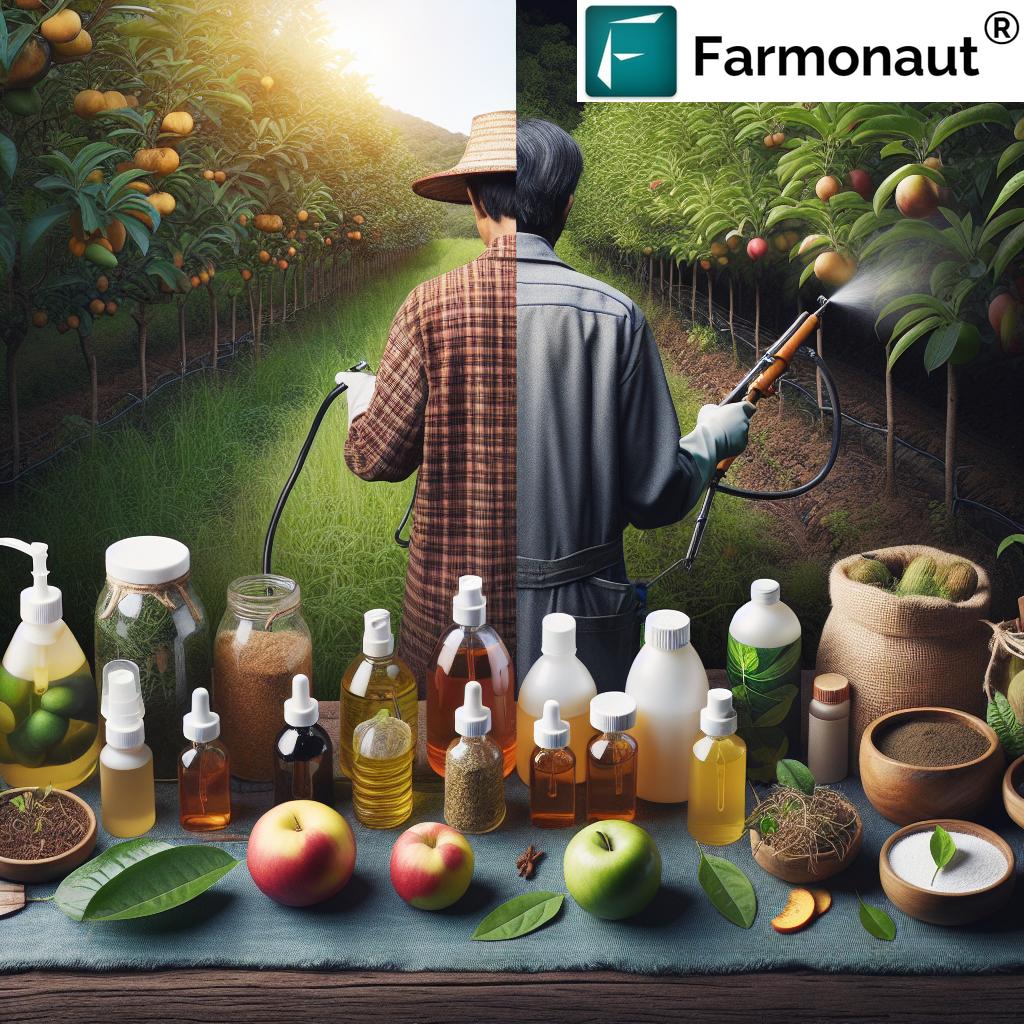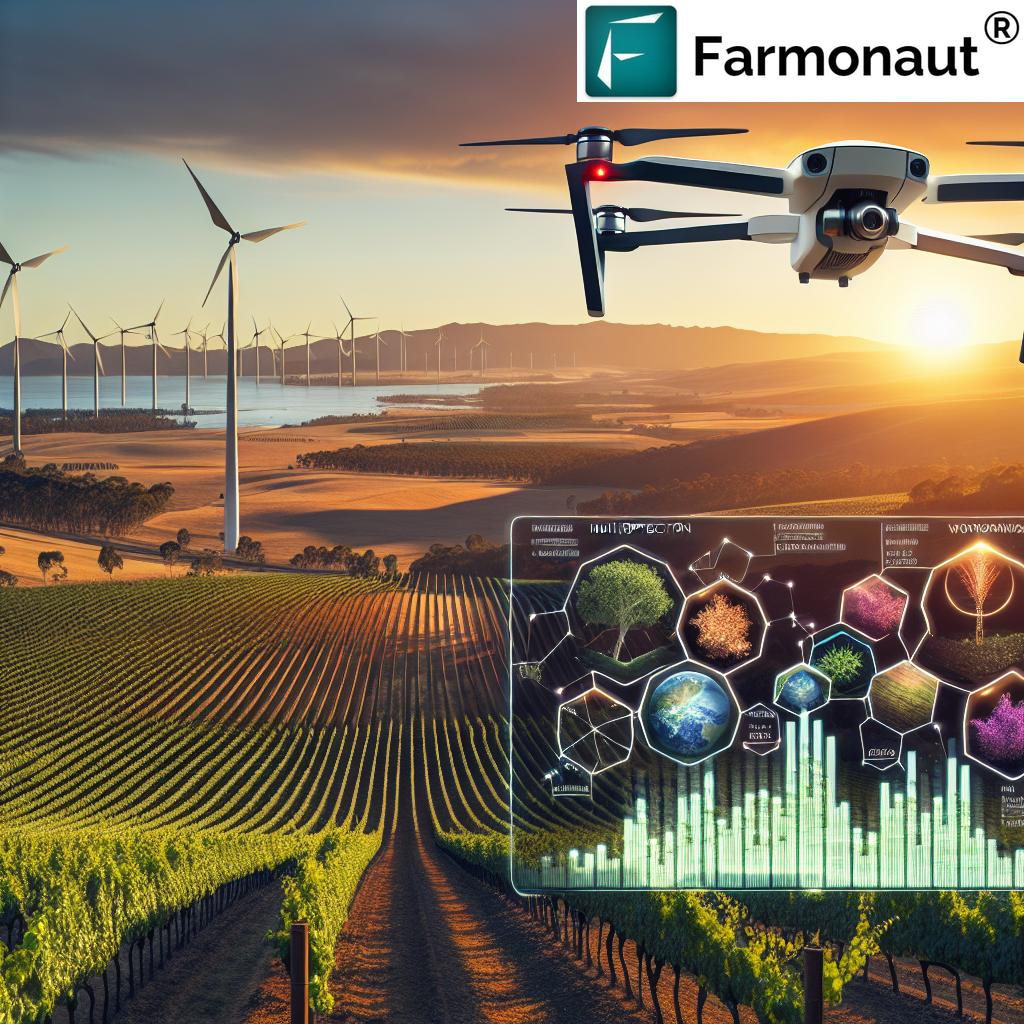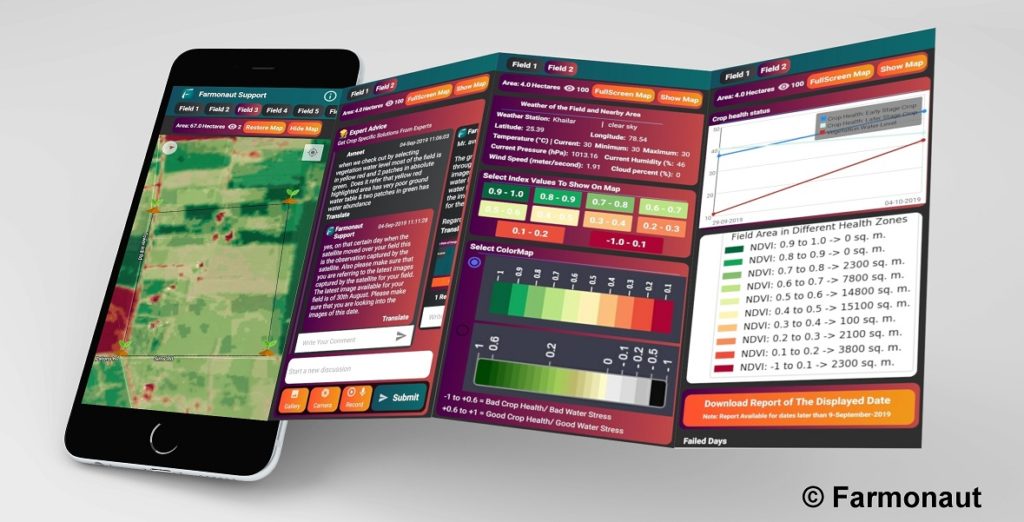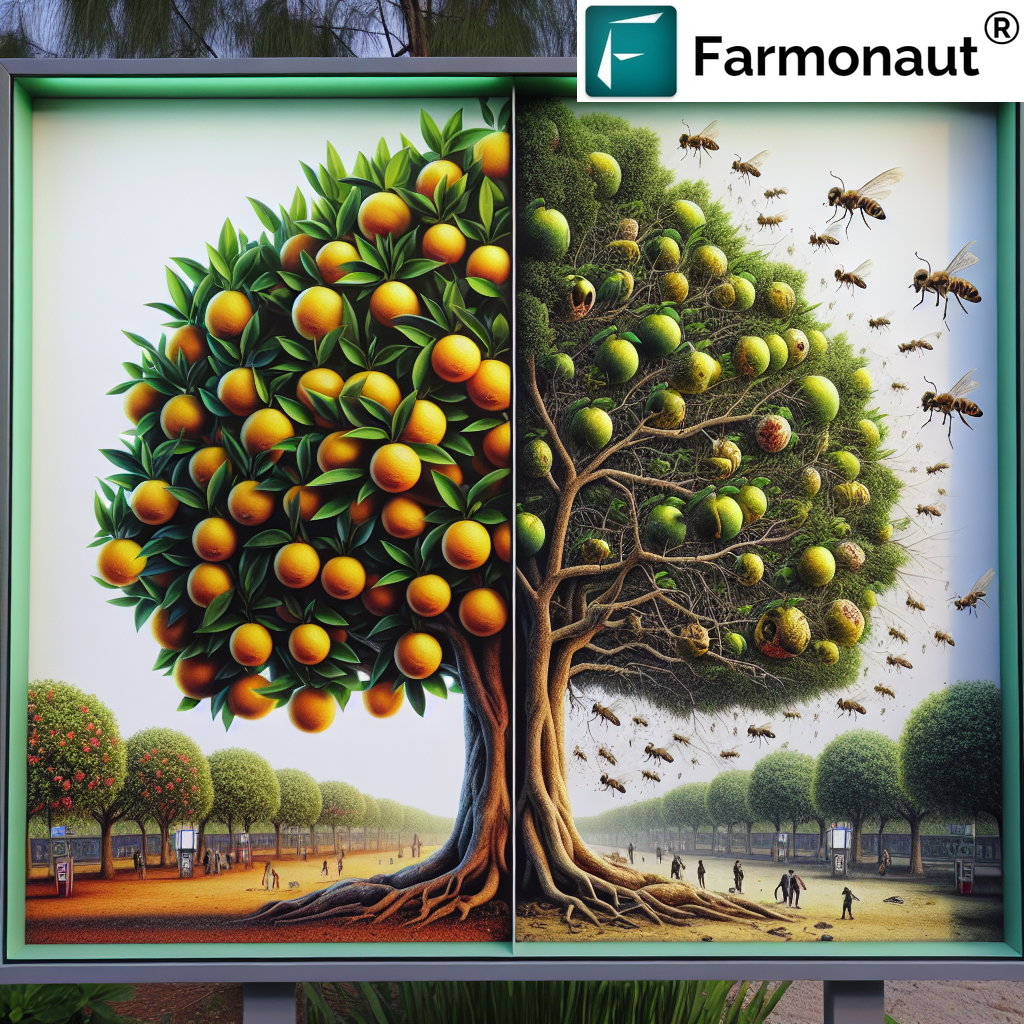Organic Treatments for Plant Diseases: Preventing Scab and Fungal Outbreaks in Fruit Trees
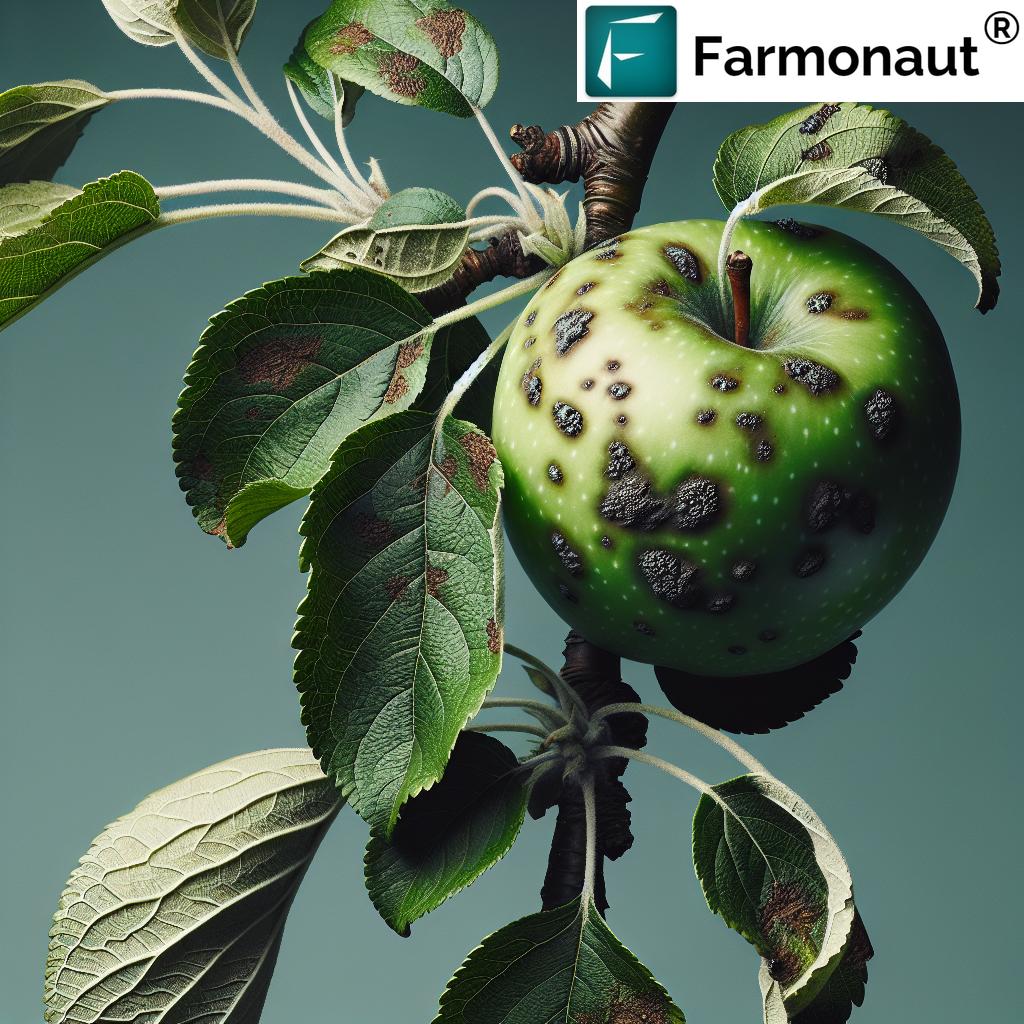
As agricultural technology experts at Farmonaut, we understand the importance of maintaining healthy fruit trees and preventing devastating plant diseases. In this comprehensive guide, we’ll explore organic treatments and preventive measures to combat common fruit tree ailments, with a particular focus on scab and fungal infections. We’ll also discuss how our advanced satellite-based monitoring system can revolutionize the way you manage your orchards.
Understanding Fruit Tree Diseases
Before diving into treatments, it’s crucial to understand the most common diseases affecting fruit trees. These include:
- Scab: A fungal disease that affects various fruit trees, particularly apples and pears
- Fire Blight: A bacterial infection that can be devastating to apple and pear trees
- Powdery Mildew: A fungal disease that appears as a white, powdery coating on leaves and fruit
- Brown Rot: A fungal disease that causes fruit to rot and can spread rapidly
Among these, scab is one of the most prevalent and challenging diseases to manage. It’s caused by the fungi Venturia inaequalis in apples and Venturia pirina in pears. The disease manifests as dark, scaly lesions on leaves, fruit, and young twigs, significantly impacting fruit quality and yield.
The Importance of Early Detection
Early detection is crucial in managing fruit tree diseases effectively. Traditional methods of disease detection often rely on visual inspection, which can be time-consuming and may miss early signs of infection. This is where Farmonaut’s satellite-based monitoring system comes into play.
Our advanced technology allows for early detection of plant stress and potential disease outbreaks across large orchards. By analyzing multispectral satellite imagery, we can identify areas of concern before visible symptoms appear, giving you a significant advantage in disease management.
| Aspect | Traditional Methods | Farmonaut Satellite System |
|---|---|---|
| Early Detection | Limited to visible symptoms | Detects plant stress before visible symptoms |
| Accuracy | Varies based on inspector’s expertise | High accuracy with AI-powered analysis |
| Coverage Area | Limited by manual inspection capabilities | Can cover vast areas quickly |
| Cost-effectiveness | Labor-intensive and time-consuming | Efficient and cost-effective for large-scale monitoring |
To learn more about how our satellite monitoring system can benefit your orchard, visit Farmonaut’s App.
Organic Treatments for Scab and Fungal Diseases
While early detection is crucial, having effective organic treatments in your arsenal is equally important. Here are some proven methods for managing scab and other fungal diseases in fruit trees:
1. Sulfur Sprays
Sulfur is a time-tested fungicide that can be effective against scab and other fungal infections. It works by preventing spore germination and inhibiting fungal growth.
- Application: Mix sulfur powder with water according to package instructions
- Timing: Apply at green tip stage and repeat every 7-10 days until petal fall
- Caution: Avoid applying sulfur when temperatures exceed 85°F (29°C) to prevent leaf burn
2. Copper-Based Fungicides
Copper fungicides are another effective organic treatment for various fruit tree diseases, including scab.
- Application: Use as a dormant spray in late winter or early spring before bud break
- Frequency: One application is usually sufficient for dormant spraying
- Caution: Excessive use can lead to copper buildup in soil, so use judiciously
3. Neem Oil
Neem oil is a versatile organic product that can help control both fungal diseases and pests.
- Application: Mix neem oil with water and a small amount of mild soap as an emulsifier
- Timing: Apply every 7-14 days during the growing season
- Benefits: Also effective against aphids, mites, and other pests
4. Potassium Bicarbonate
This compound can be effective against powdery mildew and other fungal infections.
- Application: Mix with water according to product instructions
- Frequency: Apply every 1-2 weeks during the growing season
- Advantage: Safe for use up to the day of harvest
Preventive Measures for Disease Control
While treatments are essential, prevention is always better than cure. Here are some preventive measures to reduce the risk of scab and other fungal diseases in your fruit trees:
1. Proper Sanitation
Good orchard hygiene is crucial in preventing disease outbreaks.
- Remove and destroy infected leaves and fruit promptly
- Clear fallen debris from the orchard floor regularly
- Prune and dispose of infected branches during the dormant season
2. Improve Air Circulation
Proper pruning and tree spacing can significantly reduce the risk of fungal infections.
- Prune trees to open up the canopy, allowing better air flow and sunlight penetration
- Maintain adequate spacing between trees to reduce humidity
- Consider using trellising systems for better air circulation in high-density plantings
3. Water Management
Proper watering techniques can help minimize conditions favorable for fungal growth.
- Use drip irrigation or soaker hoses to keep foliage dry
- Water early in the day to allow leaves to dry before nightfall
- Avoid overhead watering, especially during rainy periods
4. Resistant Varieties
Choosing disease-resistant fruit tree varieties can significantly reduce the need for fungicides and other treatments.
- Research and select varieties known for their resistance to scab and other common diseases
- Consider local climate and disease pressures when selecting varieties
- Consult with local extension offices or nurseries for recommendations
Implementing an Integrated Pest Management (IPM) Approach
At Farmonaut, we advocate for an Integrated Pest Management (IPM) approach, which combines various control measures to manage pests and diseases effectively while minimizing environmental impact. Here’s how you can implement IPM in your orchard:
1. Regular Monitoring
Consistent monitoring is key to successful IPM. Our satellite-based monitoring system can provide valuable insights into your orchard’s health. To learn more about our API for developers, visit Farmonaut Satellite API.
- Use our satellite monitoring system for early detection of plant stress
- Conduct regular visual inspections of your trees
- Keep detailed records of observations and treatments
2. Cultural Controls
Implement cultural practices that create unfavorable conditions for pests and diseases.
- Maintain proper tree nutrition to boost natural defenses
- Use cover crops to improve soil health and reduce pest pressure
- Practice crop rotation in nurseries and new plantings
3. Biological Controls
Encourage natural predators and beneficial organisms in your orchard.
- Plant flowering plants to attract beneficial insects
- Use pheromone traps to disrupt pest mating cycles
- Consider introducing beneficial nematodes or predatory mites
4. Chemical Controls as a Last Resort
When other methods are insufficient, use chemical controls judiciously.
- Choose the least toxic fungicides or pesticides available
- Apply treatments only when necessary, based on monitoring data
- Follow all label instructions and safety precautions
Leveraging Technology for Better Disease Management
At Farmonaut, we’re committed to bringing cutting-edge technology to farmers and orchardists. Our satellite-based monitoring system can revolutionize the way you manage diseases in your fruit trees.
Benefits of Farmonaut’s Satellite Monitoring:
- Early detection of plant stress and potential disease outbreaks
- Precise mapping of affected areas for targeted treatments
- Historical data analysis for long-term disease management strategies
- Integration with weather data for more accurate spraying schedules
To experience these benefits firsthand, download our app:
Case Study: Implementing Organic Scab Control in Apple Orchards
To illustrate the effectiveness of organic scab control methods, let’s look at a hypothetical case study of an apple orchard implementing these techniques:
Background:
- 100-acre apple orchard in a region prone to scab infections
- Previous years saw significant crop losses due to scab
- Orchard owner decided to transition to organic management practices
Implementation:
- Installed Farmonaut’s satellite monitoring system for early detection
- Implemented rigorous sanitation practices, including regular debris removal
- Applied dormant copper spray in late winter
- Used sulfur sprays during the growing season, timed based on weather data and growth stages
- Improved air circulation through proper pruning and tree spacing
- Planted resistant apple varieties in new sections of the orchard
Results:
- 50% reduction in scab incidence compared to previous years
- 30% increase in marketable fruit yield
- Reduced overall fungicide usage by 40%
- Improved fruit quality and increased demand for organic apples
This case study demonstrates the potential of combining organic treatments with advanced monitoring technology to effectively manage scab and other fruit tree diseases.
The Role of Weather in Disease Management
Weather conditions play a crucial role in the development and spread of fungal diseases like scab. Understanding and predicting weather patterns can significantly improve your disease management strategy.
Key Weather Factors:
- Temperature: Most fungal spores germinate between 55-75°F (13-24°C)
- Humidity: High humidity promotes spore germination and fungal growth
- Rainfall: Rainy periods increase the risk of spore dispersal and infection
- Leaf wetness duration: Extended periods of leaf wetness favor disease development
Farmonaut’s platform integrates weather data with satellite imagery to provide more accurate disease risk assessments. Our system can alert you to high-risk periods, allowing for timely preventive actions.
For more information on our weather API and how it can benefit your orchard management, visit Farmonaut Weather API Documentation.
Organic Fungicide Application Techniques
Proper application of organic fungicides is crucial for their effectiveness. Here are some best practices for spraying organic treatments:
1. Timing is Everything
- Apply preventive sprays before disease symptoms appear
- Time applications based on weather forecasts and disease models
- Reapply after heavy rain or as directed by product labels
2. Coverage is Crucial
- Ensure thorough coverage of all plant surfaces, including undersides of leaves
- Use proper spray equipment and nozzles for even distribution
- Consider using electrostatic sprayers for better coverage with less product
3. Mix and Apply Correctly
- Follow product label instructions for mixing ratios
- Use clean water with a pH between 6.0-7.0 for optimal effectiveness
- Apply during calm weather to minimize drift
4. Rotate Fungicides
- Alternate between different types of fungicides to prevent resistance
- Use multi-site fungicides as the backbone of your spray program
- Incorporate biofungicides into your rotation for added protection
Emerging Trends in Organic Disease Management
As agricultural technology continues to evolve, new trends are emerging in organic disease management for fruit trees. Here are some exciting developments we’re monitoring at Farmonaut:
1. Biocontrol Agents
Research into beneficial microorganisms that can suppress plant diseases is advancing rapidly. These biocontrol agents offer promising alternatives to traditional fungicides.
2. Induced Resistance
Certain compounds can trigger a plant’s natural defense mechanisms, making it more resistant to diseases. This approach could reduce the need for frequent fungicide applications.
3. Nanotechnology
Nanoparticles are being explored for their potential in delivering organic treatments more effectively, improving their efficacy and reducing the amount of product needed.
4. AI-Powered Disease Prediction
Advanced artificial intelligence algorithms, like those used in Farmonaut’s system, are becoming increasingly accurate in predicting disease outbreaks based on environmental factors and historical data.
The Economics of Organic Disease Management
Transitioning to organic disease management practices can have significant economic implications for fruit growers. Let’s explore the costs and benefits:
Costs:
- Initial investment in organic certifications and practices
- Potentially higher costs for organic fungicides and treatments
- Increased labor for monitoring and implementing cultural practices
Benefits:
- Premium prices for organic fruit in the market
- Reduced long-term costs due to improved soil and tree health
- Potential for government subsidies or grants for organic farming practices
- Reduced environmental impact and associated costs
While the initial transition to organic practices may involve some upfront costs, many growers find that the long-term benefits outweigh these initial investments. Farmonaut’s technology can help optimize this transition by providing precise data for more efficient resource allocation.
Regulatory Considerations for Organic Fruit Production
When implementing organic disease management strategies, it’s crucial to be aware of the regulatory landscape:
1. Organic Certification
- Familiarize yourself with national and regional organic standards
- Keep detailed records of all inputs and practices
- Prepare for regular inspections and audits
2. Approved Substances
- Use only fungicides and treatments approved for organic production
- Stay updated on changes to approved substance lists
- Consider working with an organic certification consultant
3. Labeling Requirements
- Understand the rules for labeling your fruit as organic
- Ensure all packaging and marketing materials comply with regulations
- Be prepared to provide traceability information for your products
Future Outlook: Sustainable Fruit Production
As we look to the future of fruit production, sustainability is at the forefront. Organic disease management practices play a crucial role in this vision. Here’s how we see the industry evolving:
- Increased integration of technology, like Farmonaut’s satellite monitoring, for precise and sustainable orchard management
- Development of more effective and environmentally friendly organic treatments
- Greater emphasis on biodiversity and ecosystem health in orchard design
- Continued research into climate-resilient fruit tree varieties
- Growing consumer demand for sustainably produced, organic fruit
By embracing these trends and continuing to innovate, we can work towards a future where healthy, delicious fruit is produced in harmony with nature.
Conclusion
Managing scab and other fungal diseases in fruit trees requires a multifaceted approach that combines organic treatments, preventive measures, and advanced monitoring technologies. By implementing these strategies and leveraging tools like Farmonaut’s satellite-based monitoring system, orchardists can significantly reduce disease incidence, improve fruit quality, and move towards more sustainable production practices.
Remember, successful disease management is an ongoing process that requires vigilance, adaptability, and a commitment to continuous learning. Stay informed about the latest research and technologies, and don’t hesitate to seek advice from agricultural extension services or consultants when needed.
At Farmonaut, we’re dedicated to supporting fruit growers in their journey towards healthier, more productive orchards. Our advanced technology provides the insights you need to make informed decisions and stay ahead of potential disease outbreaks.
Ready to take your orchard management to the next level? Subscribe to Farmonaut today and experience the power of satellite-based monitoring for yourself:
FAQs
Q: What is the most effective organic treatment for apple scab?
A: While effectiveness can vary depending on conditions, many growers find that a combination of sulfur sprays and copper-based fungicides, along with proper sanitation practices, provides good control of apple scab. It’s important to start treatments early in the season and maintain a consistent spray schedule.
Q: How often should I apply organic fungicides to my fruit trees?
A: The frequency of applications depends on the specific product, weather conditions, and disease pressure. Generally, preventive sprays are applied every 7-14 days during the growing season. Always follow the product label instructions and adjust based on monitoring results.
Q: Can I use neem oil to control scab on my pear trees?
A: While neem oil can help suppress some fungal diseases, it’s not typically considered highly effective against scab. It’s better used as part of an integrated approach, perhaps in combination with other organic treatments like sulfur or potassium bicarbonate.
Q: How does Farmonaut’s satellite monitoring help in disease management?
A: Our satellite monitoring system analyzes multispectral imagery to detect early signs of plant stress, which can indicate the onset of diseases like scab. This allows for targeted and timely interventions, potentially reducing the need for widespread fungicide applications.
Q: Are there any completely resistant apple varieties to scab?
A: While no apple variety is completely immune to scab, there are several highly resistant varieties available. Some examples include Liberty, Enterprise, and GoldRush. However, resistance can break down over time, so it’s still important to maintain good orchard hygiene and monitoring practices.
Q: How can I improve air circulation in my orchard to reduce fungal diseases?
A: Proper pruning is key to improving air circulation. Remove crossing branches, thin out dense canopies, and maintain an open center in your trees. Additionally, ensure adequate spacing between trees and consider using trellising systems in high-density plantings.
Q: Is it safe to use copper fungicides every year?
A: While copper fungicides are effective, repeated use can lead to copper accumulation in the soil. It’s best to use them judiciously, primarily as a dormant spray, and rotate with other organic treatments during the growing season. Always follow label instructions and local regulations.
Q: How can I tell if my organic disease management program is working?
A: Monitor your trees regularly for signs of disease, keep detailed records of treatments and disease incidence, and compare results year over year. Farmonaut’s satellite monitoring can provide objective data on overall tree health and stress levels, helping you assess the effectiveness of your management program.
Q: Are organic fungicides as effective as conventional ones?
A: Organic fungicides can be highly effective when used correctly as part of an integrated management approach. While they may require more frequent applications than some conventional products, they can provide good disease control while minimizing environmental impact.
Q: How can weather forecasting help in managing scab infections?
A: Weather conditions, particularly temperature and humidity, play a crucial role in scab development. By integrating weather forecasts with disease models, you can predict high-risk infection periods and time your preventive sprays more effectively. Farmonaut’s platform includes weather data integration for this purpose.
